Bell Palsy is a condition that causes facial paralysis, and was named after Sir Charles Bell (1774-1842) who described the Facial Nerve and cases of facial paralysis in his writings.
Who: 20-30 people per 100,000 people develop Bell Palsy per year. It can occur at any age, but the median age is around 40 years old.
What: by definition, it is defined as idiopathic, acute unilateral peripheral facial palsy.
Where: It usually occurs on one side of the face. Bell Palsy causes weakness or paralysis in all branches of the nerve. In other words, people show signs of weakness or paralysis in the forehead, midface, and lower face with Bell Palsy.
When: It comes on suddenly, usually within 48 hours and reaches its peak within a week. People with Bell Palsy should show some signs of recovery within 6 months of onset. If a person has complete facial paralysis with no signs of recovery at 6 months, they need further work up, because chances are it is not Bell Palsy, and they may have something serious causing their facial paralysis.
Why: When Bell Palsy was defined, it was defined as idiopathic, meaning “we don’t know what causes it”. However, new research is pointing to the herpes simplex virus type 1 as a major cause of Bell Palsy.
What to do: If you have sudden facial paralysis, you need to find out right away what is causing it so that you get the proper treatment. A physician needs to examine you and determine if it is Bells Palsy, or something more serious such as a stroke or brain tumor.
How is it treated: Initially, patients with Bells Palsy may be prescribed an anti viral medication, and/or a steroid medication to help protect the facial nerve and promote healing. If the facial weakness does not completely recover on its own, the patient may be sent to a speach, ocupational or physical therapist who specializes in treating facial paralysis to retrain the facial muscles how to work again.
Reference: The Facial Nerve by Slattery and Azizzadeh, Chapter 9 on Bells Palsy & Ramsey Hunt Syndrome by Shingo Murakami.
Painting: Green Eye Mask by Amadeo de Souza-Cardoso, 1915




